Chevrolet SPARK EV Owner's Manual
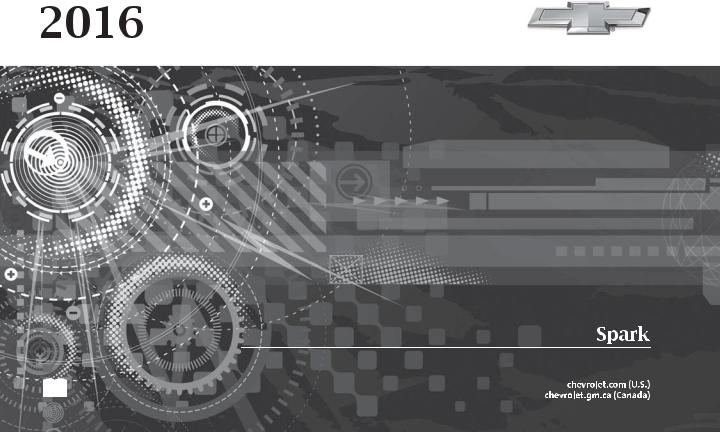

Contents
Introduction . . . . . . . . . . . . . . . . . . . . . . 2
In Brief . . . . . . . . . . . . . . . . . . . . . . . . . . . 5
Keys, Doors, and Windows . . . . . 27
Seats and Restraints . . . . . . . . . . . 43
Storage . . . . . . . . . . . . . . . . . . . . . . . . . 87
Instruments and Controls . . . . . . . 89
Lighting . . . . . . . . . . . . . . . . . . . . . . . 127
Infotainment System . . . . . . . . . . 132
Climate Controls . . . . . . . . . . . . . . 167
Driving and Operating . . . . . . . . . 173
Vehicle Care . . . . . . . . . . . . . . . . . . 213
Service and Maintenance . . . . . 277
Technical Data . . . . . . . . . . . . . . . . 286
Customer Information . . . . . . . . . 288
Reporting Safety Defects . . . . . . 299
OnStar . . . . . . . . . . . . . . . . . . . . . . . . 302
Index . . . . . . . . . . . . . . . . . . . . 312

2Introduction
Introduction
The names, logos, emblems, slogans, vehicle model names, and vehicle body designs appearing in this manual including, but not limited to, GM, the GM logo, CHEVROLET, the CHEVROLET Emblem, and SPARK are trademarks and/or service marks of General Motors LLC, its subsidiaries, affiliates,
or licensors.
For vehicles first sold in Canada, substitute the name “General Motors of Canada Limited” for Chevrolet Motor Division wherever it appears in this manual.
Litho in U.S.A.
Part No. 23210874 A First Printing
This manual describes features that may or may not be on the vehicle because of optional equipment that was not purchased on the vehicle, model variants, country specifications, features/applications that may not be available in your region, or changes subsequent to the printing of this owner manual.
Refer to the purchase documentation relating to your specific vehicle to confirm the features.
Keep this manual in the vehicle for quick reference.
Canadian Vehicle Owners
A French language manual can be obtained from your dealer, at www.helminc.com, or from:
Propriétaires Canadiens
On peut obtenir un exemplaire de ce guide en français auprès du concessionnaire ou à l'adresse suivante:
Helm, Incorporated
Attention: Customer Service
47911 Halyard Drive
Plymouth, MI 48170
USA
Using this Manual
To quickly locate information about the vehicle, use the Index in the back of the manual. It is an alphabetical list of what is in the manual and the page number where it can be found.
Danger, Warning, and
Caution
Warning messages found on vehicle labels and in this manual describe hazards and what to do to avoid or reduce them.
© 2015 General Motors LLC. All Rights Reserved.

{Danger
Danger indicates a hazard with a high level of risk which will result in serious injury or death.
{Warning
Warning indicates a hazard that could result in injury or death.
Caution
Caution indicates a hazard that could result in property or vehicle damage.
A circle with a slash through it is a safety symbol which means “Do Not,” “Do not do this,” or “Do not let this happen.”
Symbols
The vehicle has components and labels that use symbols instead of text. Symbols are shown along with the text describing the operation or information relating to a specific component, control, message, gauge, or indicator.
M : Shown when the owner manual has additional instructions or information.
* : Shown when the service manual has additional instructions or information.
0 : Shown when there is more information on another page — “see page.”
Vehicle Symbol Chart
Here are some additional symbols that may be found on the vehicle and what they mean. For more information on the symbol, refer to the Index.
Introduction 3
9 : Airbag Readiness Light
! : Antilock Brake System (ABS)
G: Air Conditioning Refrigerant Oil
5/g : Audio Steering Wheel Controls or OnStar® (if equipped)
$ : Brake System Warning Light
" : Charging System (12-Volt Battery)
I : Cruise Control
` : Do Not Puncture
^ : Do Not Service
O : Exterior Lamps
_ : Flame/Fire Prohibited
# : Fog Lamps
g: First Responder
+ : Fuses
3 : Headlamp High/Low-Beam Changer
_: High Voltage
j : LATCH System Child Restraints
[: Energy Usage and Charge Mode Selection
O : Power

4Introduction
B : Remote Vehicle Start
> : Safety Belt Reminders
B : Service Vehicle Soon
g : StabiliTrak® Off
7 : Tire Pressure Monitor
d : Traction Control/StabiliTrak®
i : Traction Control Off
a : Under Pressure
Q: Vehicle Ready
M : Windshield Washer Fluid

In Brief
Instrument Panel
Instrument Panel . . . . . . . . . . . . . . . . 6
Initial Drive Information
Initial Drive Information . . . . . . . . . . 7
Remote Keyless Entry (RKE)
System . . . . . . . . . . . . . . . . . . . . . . . . 7
Remote Start . . . . . . . . . . . . . . . . . . . . 8
Door Locks . . . . . . . . . . . . . . . . . . . . . 9
Liftgate . . . . . . . . . . . . . . . . . . . . . . . . . . 9
Windows . . . . . . . . . . . . . . . . . . . . . . . 10
Seat Adjustment . . . . . . . . . . . . . . . 10
Second Row Seats . . . . . . . . . . . . 11
Head Restraint Adjustment . . . . 11
Safety Belts . . . . . . . . . . . . . . . . . . . . 11
Passenger Sensing System . . . 12
Mirror Adjustment . . . . . . . . . . . . . . 12
Steering Wheel Adjustment . . . . 13
Interior Lighting . . . . . . . . . . . . . . . . 13
Exterior Lighting . . . . . . . . . . . . . . . 13
Windshield Wiper/Washer . . . . . . 14
Climate Controls . . . . . . . . . . . . . . . 14
Vehicle Features
Radio(s) . . . . . . . . . . . . . . . . . . . . . . . 15
Satellite Radio . . . . . . . . . . . . . . . . . 15
Portable Audio Devices . . . . . . . . 16
Bluetooth® . . . . . . . . . . . . . . . . . . . . . 16
In Brief |
5 |
Steering Wheel Controls . . . . . . . 16
Cruise Control . . . . . . . . . . . . . . . . . 16
Driver Information
Center (DIC) . . . . . . . . . . . . . . . . . 17
Rear Vision Camera (RVC) . . . . 17
Power Outlets . . . . . . . . . . . . . . . . . 17
Battery and Efficiency
High Voltage Safety
Information . . . . . . . . . . . . . . . . . . . 18
Charging . . . . . . . . . . . . . . . . . . . . . . . 18
Regenerative Braking . . . . . . . . . . 23
Service . . . . . . . . . . . . . . . . . . . . . . . . 24
Performance and Maintenance
Traction Control/Electronic
Stability Control . . . . . . . . . . . . . . 24
Tire Pressure Monitor . . . . . . . . . . 24
Driving for Better Energy
Efficiency . . . . . . . . . . . . . . . . . . . . . 25
Roadside Assistance
Program . . . . . . . . . . . . . . . . . . . . . . 26

6In Brief
Instrument Panel

1.Air Vents 0 170.
2.Exterior Lamp Controls 0 127.
Turn Signal Lever. See Turn and Lane-Change
Signals 0 129.
3.Horn 0 91.
4.Instrument Cluster 0 94.
5.Windshield Wiper/Washer 0 91.
6.Infotainment 0 132.
7.Information Display.
8.Hazard Warning Flashers 0 129.
9.Leaf Button. See Power Flows 0 106.
10.Automatic Climate Control System 0 167.
11.Power Outlets 0 93.
12.Heated Front Seats 0 47 (If Equipped).
13.Electric Parking Brake 0 191.
14.Sport Mode Button. See Driver Selected Operating
Modes 0 188.
15.Traction Control/Electronic Stability Control 0 194.
16.Shift Lever. See Electric Drive Unit 0 189.
17.Power Button 0 184.
18.Steering Wheel Controls 0 90
(If Equipped).
19.Steering Wheel Adjustment 0 90.
20.Cruise Control 0 196 (If Equipped).
21.Driver Information Center (DIC) 0 114.
Instrument Panel Illumination Control 0 130.
22.Instrument Panel Fuse Block 0 235.
23.Hood Release. See
Hood 0 216.
24.Power Mirrors 0 40 (If Equipped).
In Brief |
7 |
Initial Drive
Information
This section provides a brief overview about some of the important features that may or may not be on your specific vehicle.
For more detailed information, refer to each of the features which can be found later in this owner manual.
Remote Keyless Entry
(RKE) System
The RKE transmitter may work up to 60 m (195 ft) away from the vehicle.

8In Brief
With DC Charging Button Shown,
Without DC Charging Similar
Press the key release button to extend the key. The key can be used for all locks.
K : Press once to unlock the driver door. Press a second time within five seconds to unlock all doors.
Q : Press to lock all doors.
Lock and unlock feedback can be personalized. See Vehicle Personalization 0 121.
7 : Press and release to initiate vehicle locator. Press and hold for three seconds to sound the panic alarm. Press again to cancel the panic alarm.
U : Press and release Q and then immediately press and hold Ufor at least four seconds to start the vehicle's heating or air conditioning systems and rear window defogger from outside the vehicle using the RKE transmitter. See Remote Start 0 32.
W: If equipped, press and hold to stop the charge. See Plug-In Charging 0 201.
See Keys 0 27 and Remote Keyless Entry (RKE) System Operation 0 29.
Remote Start
Use remote start to heat or cool the interior when the vehicle is plugged in to maximize electric range by utilizing electricity from the electrical outlet. The vehicle may start to support the climate control
operation. Normal operation of the system will return after the vehicle has been turned on.
Starting the Vehicle
1.Press and release Q.
2.Immediately, press and hold Ufor at least
four seconds or until the turn signal lamps flash.
After entering the vehicle during a remote start, press the O POWER button on the center stack with the brake pedal applied to operate as normal.
Remote Start can be extended.
Canceling Remote Start
To cancel a remote start, do any of the following:
.Press and hold Uuntil the parking lamps turn off.
.Turn on the hazard warning flashers.

.Press O POWER on the center stack, with the brake pedal applied, then press O POWER again to turn the vehicle off.
See Remote Start 0 32.
Door Locks
To lock or unlock the doors from outside the vehicle:
.Use the key in the driver door to lock and unlock the door.
.Press Q or K on the Remote Keyless Entry (RKE) transmitter to lock and unlock the doors. See Remote Keyless Entry (RKE) System Operation 0 29.
In Brief |
9 |
To open the liftgate, pull the handle and lift up.
When closing the liftgate, use the pull cup.
To lock the liftgate, press Q on a power door lock switch or on the RKE transmitter, or use the key in the lock cylinder.
See Liftgate 0 36.

10 In Brief
Windows |
Seat Adjustment |
Seat Height Adjuster |
|
Manual Seats |
|
Press the switch down to open the window. Pull the front of the switch up to close it.
The switches work when the vehicle is in ON/RUN or when Retained Accessory Power (RAP) is active.
See Retained Accessory Power
(RAP) 0 41 and Power
Windows 0 41.
To adjust the seat:
1.Lift the bar under the front edge of the seat cushion to unlock the seat.
2.Slide the seat to the desired position and release the bar.
3.Try to move the seat back and forth to be sure it is locked in place.
See Seat Adjustment 0 45.
If available, turn the knob to raise or lower the seat.
See Seat Adjustment 0 45.

Reclining Seatbacks
To recline the seatback:
1.Lift the lever.
2.Move the seatback to the desired position, and then release the lever to lock the seatback in place.
3.Push and pull on the seatback to make sure it is locked in place.
To return the seatback to the upright position:
1.Lift the lever fully without applying pressure to the seatback, and the seatback will return to the upright position.
2.Push and pull on the seatback to make sure it is locked.
See Reclining Seatbacks 0 45.
Second Row Seats
The rear seatbacks can be folded down to increase cargo space.
See Rear Seats 0 47.
Head Restraint
Adjustment
Do not drive until the head restraints for all occupants are installed and adjusted properly.
To achieve a comfortable seating position, change the seatback recline angle as little as necessary while keeping the seat and the head restraint height in the proper position.
See Head Restraints 0 43 and Seat
Adjustment 0 45.
In Brief |
11 |
Safety Belts
Refer to the following sections for important information on how to use safety belts properly.
.Safety Belts 0 49.
.How to Wear Safety Belts Properly 0 50.
.Lap-Shoulder Belt 0 51.
.Lower Anchors and Tethers for Children (LATCH System) 0 74.

12 In Brief
Passenger Sensing
System
United States
Canada and Mexico
The passenger sensing system turns off the front outboard passenger frontal airbag and knee airbag under certain conditions. No other airbag is affected by the passenger sensing system. See
Passenger Sensing System 0 61 for important information.
The passenger airbag status indicator will be visible on the center display when the vehicle is started. See Passenger Airbag Status Indicator 0 100.
Mirror Adjustment
Exterior Mirrors
1.Move the selector switch to L (Left) or R (Right) to choose the driver or passenger mirror.
2.Move the control up, down, or side to side to adjust the mirror.
3.Return the selector switch to the center when done.
See Power Mirrors 0 40.
Folding Mirrors
The vehicle has manual folding mirrors. These mirrors can be folded inward to prevent damage when going through an automatic car wash. To fold, pull the mirror toward the vehicle. Push the mirror outward to return it to the original position.
See Folding Mirrors 0 40.
Interior Mirror
Manual Rearview Mirror
To avoid glare of the headlamps from behind, pull the tab backward for nighttime use. Push the tab forward for daytime use.

Steering Wheel
Adjustment
To adjust the steering wheel:
1.Pull the lever down.
2.Move the steering wheel up or down.
3.Pull the lever up to lock the steering wheel in place.
Do not adjust the steering wheel while driving.
Interior Lighting
Dome Lamps
The dome lamp controls are in the overhead console.
Move the control to change the lamp setting.
OFF : Turns the lamps off, even when a door is open.
DOOR : Turns the lamps on automatically when a door is opened.
ON : Turns on the dome lamps.
In Brief |
13 |
For more information about interior lighting, see Instrument Panel Illumination Control 0 130
or Courtesy Lamps 0 130.
Exterior Lighting
The exterior lamp control is on the turn signal lever on the left side of the steering column.
There are four positions:
3 : Turns on the headlamps together with the parking lamps and instrument panel lights.
; : Turns on the parking lamps including all lamps, except the headlamps.

14 In Brief
AUTO : Turns the exterior lamps on and off automatically depending on the exterior light.
O : Turns all the lamps off, except the Daytime Running Lamps (DRL).
The DRL automatically turn off when the vehicle is turned off.
See Exterior Lamp Controls 0 127 and Daytime Running Lamps (DRL) 0 128.
Windshield Wiper/Washer
The windshield wiper/washer lever is on the right side of the steering column.
Move the lever to one of the following positions:
HI : Use for fast wipes.
LO : Use for slow wipes.
INT : Move the lever up to INT for intermittent wipes, then turn the x INT band up for more frequent wipes or down for less frequent wipes.
OFF : Use to turn the wipers off.
8 : For a single wipe, briefly move the wiper lever down. For several wipes, hold the wiper lever down.
Windshield Washer
Pull the windshield wiper lever toward you to spray windshield washer fluid and activate the wipers.
Rear Wiper/Washer
If equipped with the rear wiper/ washer, the controls are on the end of the windshield wiper lever.
ON : Turns the rear wiper on for continuous wipes.
OFF : Turns the rear wiper off.
= : Sprays washer fluid on the rear window. The control returns to its ON or OFF starting position when released.
See Windshield Wiper/Washer 0 91 or Rear Window Wiper/Washer 0 92
(If Equipped).
Climate Controls
The heating, cooling, and ventilation for the vehicle can be controlled with this system.

1.Temperature Control
2.Defrost
3.Air Delivery Mode Control
4.Rear Window Defogger
5.Fan Control
6.Recirculation
7.AUTO (Automatic Operation)
8.TEMP (Air Conditioning/Heater Power)
See Automatic Climate Control
System 0 167.
Vehicle Features
Radio(s)
z VOL y : Touch to decrease or increase the volume.
O : Press and hold to turn the power on and off.
Buttons 1−5 : Touch the screen buttons to save and select favorite stations.
For more information about these and other radio features, see
Operation 0 135.
Storing a Favorite Station
Stations from all bands can be stored in the favorite lists in any order. Up to five stations can be stored in each of the seven favorite pages.
To store the station to a position in the list, press the corresponding screen button 1−5 until a beep is heard.
For more information, see “Storing a Station as a Favorite” in AM-FM Radio 0 136.
In Brief |
15 |
Setting the Clock
See Clock 0 93.
Satellite Radio
If equipped, vehicles with a SiriusXM® satellite radio tuner and a valid SiriusXM satellite radio subscription can receive SiriusXM programming.
SiriusXM Satellite Radio
Service
SiriusXM is a satellite radio service based in the 48 contiguous United States and 10 Canadian provinces. SiriusXM satellite radio has a wide variety of programming and commercial-free music, coast to coast, and in digital-quality sound. A fee is required to receive the SiriusXM service.
Refer to:
.www.siriusxm.com or call 1-866-635-2349 (U.S.).
.www.xmradio.ca or call 1-877-209-0079 (Canada).
See Satellite Radio 0 138.

16 In Brief
Portable Audio Devices
The vehicle has a 3.5 mm (1/8 in) auxiliary input and a USB port in the center stack. External devices such as iPods®, laptop computers, MP3 players, CD changers, and USB drives may be connected, depending on the audio system.
See Auxiliary Devices 0 141.
Bluetooth®
The Bluetooth® system allows users with a Bluetooth-enabled cell phone to make and receive hands-free calls using the vehicle audio system and controls.
The Bluetooth-enabled cell phone must be paired with the in-vehicle Bluetooth system before it can be used in the vehicle. Not all phones will support all functions.
See Bluetooth (Overview) 0 143 or Bluetooth (Infotainment
Controls) 0 144.
Steering Wheel Controls
If equipped with audio steering wheel controls, some audio controls can be adjusted at the steering wheel.
¦ SEEK or SEEK ¥ : Press to go to the next or previous radio station, song on an iPod®, or file on a USB device (if equipped).
5 / g : If equipped with Bluetooth or OnStar, press to interact with those systems. See Bluetooth (Overview) 0 143 or Bluetooth (Infotainment Controls) 0 144
or OnStar Overview 0 302.
> / R: Press to silence the vehicle speakers only. Press again to turn the sound on. If equipped with OnStar or Bluetooth systems, press to decline an incoming call, to end speech recognition, or to end a current call.
x + or x − : Press + or − to increase or decrease the volume.
Cruise Control
If equipped with cruise control:
I : Press to turn the cruise control system on and off. A cruise control indicator light turns on when in use.
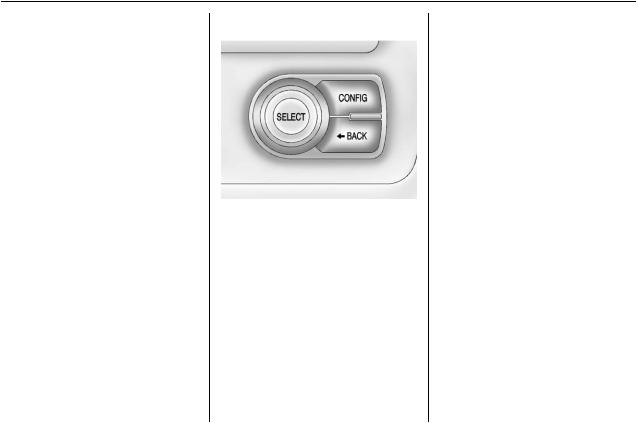
RES/+ : If there is a set speed in memory, press briefly to resume to that speed or press and hold to accelerate. If cruise control is already active, use to increase vehicle speed.
SET/− : Press briefly to set the speed and activate cruise control. If cruise control is already active, use to decrease vehicle speed.
* : Press to disengage cruise control without erasing the set speed from memory.
See Cruise Control 0 196.
Driver Information
Center (DIC)
The DIC has different displays, which can be accessed by using the DIC buttons to the left of the steering wheel. The DIC displays information about the vehicle and warning messages if a system problem is detected.
DIC Controls
CONFIG : Press to change the instrument cluster display configuration. See Instrument Cluster 0 94.
} BACK : Press to return to the previous screen, exit a screen,
or return to the main menu. Press } BACK to minimize the DIC menu display.
SELECT : Press the center of the knob to select the highlighted item. Turn the knob to scroll through the menu items.
See Driver Information Center (DIC) 0 114.
In Brief |
17 |
Rear Vision
Camera (RVC)
If equipped, RVC displays a view of the area behind the vehicle, on the infotainment system display, when the vehicle is shifted into
R (Reverse).
See Rear Vision Camera (RVC) 0 199.
Power Outlets
The accessory power outlets can be used to plug in electrical equipment, such as a cell phone or MP3 player.
The vehicle may have accessory power outlets:
.On the center stack below the climate control.
.On the rear of the center console.
See Power Outlets 0 93.

18 In Brief
Battery and Efficiency
High Voltage Safety
Information
{Warning
Exposure to high voltage can cause shock, burns, and even death. The high voltage components in the vehicle can only be serviced by technicians with special training.
High voltage components are identified by labels. Do not remove, open, take apart,
or modify these components. High voltage cable or wiring has orange covering or labels. Do not probe, tamper with, cut, or modify high voltage cable or wiring.
This vehicle has a high voltage battery and a standard 12-volt battery.
If the vehicle is in a crash, the sensing system may shut down the high voltage system. When this occurs, the high voltage battery is disconnected and the vehicle will not start. The SERVICE VEHICLE SOON message in the Driver Information Center (DIC) will be displayed. Before the vehicle can be operated again, it must be serviced at your dealer.
{Warning
Damage to the high voltage battery or high voltage system can create a risk of electric shock, overheating, or fire.
If the vehicle is damaged from a moderate to severe crash, flood, fire, or other event, the vehicle should be inspected as soon as possible. Until the vehicle has been inspected, store it outside at least 15 m (50 ft) from any structure or anything that can burn. Ventilate the vehicle by opening a window or a door.
(Continued)
Warning (Continued)
Contact Spark EV Customer Assistance at 1 855-477-2754 (1-855-4-SPARK-INFO) as soon as possible to determine whether an inspection is needed.
See Battery - North America 0 224 for important safety information.
If an airbag has inflated, see What Will You See after an Airbag Inflates? 0 60.
Only a trained service technician with the proper knowledge and tools should inspect, test, or replace the high voltage battery. See your dealer if the high voltage battery needs service.
See Battery - North America 0 224.
Charging
This section explains the process for charging the high voltage battery. Do not allow the vehicle to remain in temperature extremes for long periods without being driven or plugged in. It is recommended that
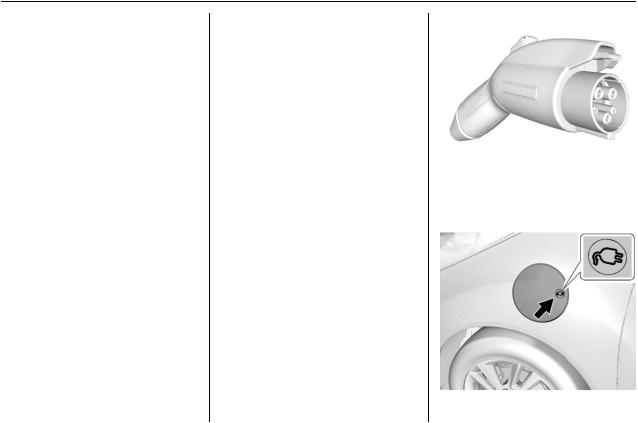
the vehicle be plugged in when temperatures are below 0 °C (32 °F) and above 32 °C (90 °F) to maximize high voltage battery life.
Do not turn the vehicle on during charging. Turning the vehicle on or activating remote start while the vehicle is charging may use more energy than the charger provides and may cause the charging process to deactivate.
When using a 240-volt charging station, it will take approximately seven hours to charge the vehicle from empty to full. When using a 120-volt AC electrical outlet, it will take approximately 20 hours to charge the vehicle with the 12 amp AC current setting, and considerably longer using the default 8 amp AC current setting. Charge times will vary with outside temperature. There are three ways to program how the vehicle is charged. See
Programmable Charging 0 106.
If equipped, the vehicle can be charged using DC charging equipment found at service stations and other public locations.
When using a DC charging station with at least 50kW of available power, it will take approximately 20 minutes to recharge from a
depleted battery to a level of 80% of the driving range available for use. This time estimate is applicable to nominal temperature ranges. In extreme hot or cold conditions, this time may be lengthened. When a full charge is desired, the charging time will be increased.
The charging system may run fans and pumps that result in sounds from the vehicle while it is turned off. Additionally, clicking sounds may be caused by the electrical devices used while charging.
While the charge cord is plugged into the vehicle, the vehicle cannot be driven.
In Brief |
19 |
AC Charging
AC Charge Cord Vehicle Plug
Start Charge
1.Make sure the vehicle is parked and turned off.
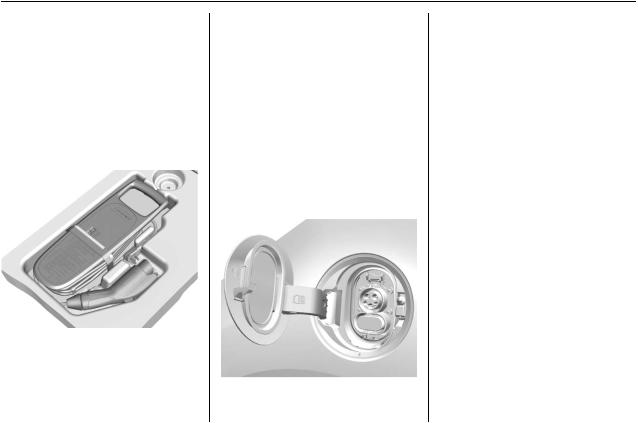
20 In Brief
2.Push mon the charge port door and release to open the door.
In cold weather conditions, ice may form around the charge port door. The charge port door may not open on the first attempt. Remove ice from the area and repeat attempting to open the charge port door.
3.Open the rear hatch, lift the load support floor covering, and remove the charge cord. It is located near the tire sealant and compressor kit. Pull up on the charge cord
handle to release it from the handle clip. Lift the charge cord up and rearward to remove it from the vehicle. The vehicle plug is stored as shown.
4.Plug the charge cord into the electrical outlet. See Electrical Requirements for Battery Charging 0 210. Verify the charge cord status. See the charge cord user guide and
Charge Cord 0 209. Select the appropriate charge level. See
Programmable Charging 0 106.
5.Plug in the AC vehicle plug of the charge cord into the charge port on the vehicle. Make sure
the AC vehicle plug is fully connected to the AC charge port. If it is not properly seated, the charge may not occur.
6.Verify that the Charging Status Indicator illuminates on top of the instrument panel and a horn chirp occurs. See
Charging Status Feedback 0 205.
End Charge
1.Unlock the vehicle with the RKE transmitter to disarm the charge cord theft alert.
2.Unplug the vehicle plug of the charge cord from the vehicle. Unlock the vehicle plug of the charge cord from the vehicle by pushing the button on the top of the charge cord plug.
3.Close the charge port door by pressing firmly in the center to latch properly.
4.Unplug the charge cord from the electrical outlet.
5.Place the charge cord into the storage compartment.

Charge Cord
See Radio Frequency
Statement 0 298.
A portable charge cord used to charge the vehicle high voltage battery is stored in the rear hatch.
Important Information About
Portable Electric Vehicle Charging
.Charging an electric vehicle can stress a building’s electrical system more than a typical household appliance.
.Before you plug in to any electrical outlet, have a qualified electrician inspect and verify the electrical system (electrical outlet, wiring, junctions, and protection devices) for heavy-duty service at a 12 amp continuous load.
.Electrical outlets may wear out with normal usage or may be damaged over time, making them unsuitable for electric vehicle charging.
.Check the electrical outlet/plug while charging and discontinue use if the electrical outlet/plug is hot, then have the electrical outlet serviced by a qualified electrician.
.When outdoors, plug into an electrical outlet that is weather-proof while in use.
.Mount the charge cord to reduce strain on the electrical outlet/plug.
{Warning
Improper use of portable electric vehicle charge cords may cause a fire, electrical shock, or burns, and may result in damage to property, serious injury, or death.
.Do not use extension cords, multi-outlet power strips, splitters, grounding adaptors, surge protectors, or similar devices.
(Continued)
In Brief |
21 |
Warning (Continued)
.Do not use an electrical outlet that is worn or damaged, or one that will not hold the plug firmly in place.
.Do not use an electrical outlet that is not properly grounded.
.Do not use an electrical outlet that is on a circuit with other electrical loads.
See the charge cord user guide.
Charge Cord Status Indicators
See “Charge Cord Status Indicators” in the charge cord user guide.
Charge Level Selection
Charge level selection can be made using the Change Charge Level Preference screen on the center stack. See “Charge Level Selection” under Programmable
Charging 0 106.

22 In Brief
{Warning
Using a charge level that exceeds the electrical circuit or electrical outlet capacity may start a fire or damage the electrical circuit. Use the lowest charge level until a qualified electrician inspects the electrical circuit capacity. Use the lowest charge level if the electrical circuit or electrical outlet capacity is not known.
DC Charging
Start Charge
Starting a DC charge requires the vehicle to be off until charging has started. If for any reason DC charging does not begin or is interrupted, check the DC charge station display for messages. Unplug to restart the DC charge process.
1.Make sure the vehicle is parked and turned off.
2.Push mon the charge port door and release to open the door.
In cold weather conditions, ice may form around the charge port door. The charge port door may not open on the first attempt. Remove ice from the area and repeat attempting to open the charge port door.
3.Unlatch the DC charging dust cover and lower it fully.
4.Plug in the DC vehicle plug into the DC charge port on the vehicle. Make sure that the DC vehicle plug is fully connected
to the DC charge port. If it is not properly seated then the charge may not occur. Proper plug connection can be can be checked by information on
the DIC.
5.Follow the steps listed on the charging station to start charging. The Electric Parking Brake will automatically apply once the charge process has been started.
6.Once charging, the DC vehicle plug will be locked to the DC charge port and cannot be disconnected while charging is active.
7.Verify the charging status indicator illuminates on top of the instrument panel and a horn chirp occurs. See
Charging Status Feedback 0 205.

Caution
Do not attempt to disconnect the DC vehicle plug while charging is active. This action may damage vehicle or charging station hardware.
Stop Charge
Controls on the charging station can be used to stop the charge process at any time.
To stop charging using the RKE transmitter, press and hold the stop charge button. This only applies to DC charging. The latch button on the DC vehicle plug should not be used to stop charging.
Additionally, to stop the charge when inside the vehicle, you may use the stop charging button on the Battery Information Screen.
Stop Charge — Automatic
When the vehicle no longer needs to use power from the charging station, it will stop charging and the DC vehicle plug will be unlocked from the DC charge port.
Energy can still be consumed from the charging station when the vehicle displays and indicators show that the battery is fully charged. This is to ensure the battery is in optimal temperature operating range to maximize vehicle range. See
Programmable Charging 0 106.
The process can be stopped by using the procedure to stop charging manually.
End Charge
1.Wait until the charging process has been fully stopped and the Charging Status Indicator is no longer solid green.
2.Unlock the vehicle with the RKE transmitter to disarm the charge cord theft alert.
In Brief |
23 |
3.Unplug the DC vehicle plug from the DC charge port on the vehicle.
4.Close the charge port door by pressing firmly in the center to latch properly.
5.The Electric Parking Brake should be manually disengaged before driving the vehicle.
6.To start another DC charge, remove the DC vehicle plug and reconnect.
Regenerative Braking
Regenerative braking takes some of the energy from the moving vehicle and turns it back into electrical energy. This energy is then stored in the high voltage battery system, contributing to increased energy efficiency.
See Regenerative Braking 0 194.

24 In Brief
Service
{Warning
Never try to do your own service on high voltage components. You can be injured and the vehicle can be damaged if you try to do your own service work. Service and repair of these high voltage components should only be performed by a trained service technician with the proper knowledge and tools. See Doing Your Own Service Work 0 215.
Performance and
Maintenance
Traction Control/
Electronic Stability
Control
The Traction Control System (TCS) limits wheel spin. The system turns on automatically every time the vehicle is started.
The StabiliTrak system assists with directional control of the vehicle in difficult driving conditions. The system also turns on automatically every time the vehicle is started.
.To turn off traction control, press and release g on the center console behind the shift lever. The traction off light i illuminates, and the appropriate DIC message is displayed. See
Ride Control System Messages 0 119.
.To turn off both traction control
and StabiliTrak, press and hold g, until the traction off light i
and the StabiliTrak OFF light g illuminate. The appropriate DIC messages are displayed. See
Ride Control System Messages 0 119.
.Press and release g again to turn on both systems.
See Traction Control/Electronic
Stability Control 0 194.
Tire Pressure Monitor
This vehicle may have a Tire Pressure Monitor System (TPMS).
The low tire pressure warning light alerts to a significant loss in pressure of one of the vehicle's tires. If the warning light comes on, stop as soon as possible and inflate the tires to the recommended pressure shown on the Tire and Loading Information label.

See Vehicle Load Limits 0 181. The warning light will remain on until the tire pressure is corrected.
The low tire pressure warning light may come on in cool weather when the vehicle is first started, and then turn off as the vehicle is driven. This may be an early indicator that the tire pressures are getting low and the tires need to be inflated to the proper pressure.
The TPMS does not replace normal monthly tire maintenance. Maintain the correct tire pressures.
See Tire Pressure Monitor
System 0 245.
Driving for Better Energy Efficiency
Use the following tips to help maximize energy efficiency and range.
In colder temperatures, while these efficiency tips will help, the electric vehicle driving range may be lower due to higher energy usage.
Driving Style
Efficiency Gauge (Instrument
Cluster)
The ball indicator should be kept green and in the center of the gauge.
Inefficient acceleration is indicated when the ball turns yellow and travels above the center of the gauge.
Aggressive braking is indicated when the ball turns yellow and travels below the center of the gauge.
Acceleration/Braking/Coasting
Avoid unnecessary rapid accelerations and decelerations.
Electric range is maximized at
80 km/h (50 mph) and below. Higher speeds use more energy and can significantly reduce electric range.
Use cruise control when appropriate.
In Brief |
25 |
Plan ahead for decelerations and coast whenever possible. For example, do not rush to traffic signals.
Do not shift to N (Neutral) to coast. The vehicle recovers energy while coasting and braking in D (Drive) or L (Low).
Drive Mode and PRNDL
Selection
Use Normal Mode when possible.
Sport Mode provides more responsive acceleration than Normal Mode but can reduce efficiency.
Use L (Low) in heavy stop-and-go traffic or when traveling downhill. L (Low) requires less brake pedal application and provides a controlled, efficient way to slow the vehicle down.
Climate Setting
Using the heat and air conditioning systems decreases the energy available for electric driving.

26 In Brief
Optimal energy efficiency is achieved with the heat, air conditioning, and fan turned off.
Operating with the TEMP button off is the most energy efficient climate
setting as long as 0 is not selected.
Use the heated seat feature instead of climate settings. Heating the seat uses less energy than heating the vehicle interior.
Use remote start to heat or cool the interior when the vehicle is plugged in to maximize the electric range by utilizing electricity from the electrical outlet.
In hot weather, avoid parking in direct sunlight or use sunshades inside the vehicle.
Turn off the front and rear window defog/defrost when they are no longer needed.
Avoid driving with the windows open at highway speeds.
Vehicle Charging/Maintenance
Charging
Keep the vehicle plugged in, even when fully charged, to keep the battery temperature ready for the next drive. This is important when outside temperatures are extremely hot or cold.
Maintenance
Always keep the tires properly inflated and the vehicle properly aligned.
The weight of excess cargo in the vehicle affects efficiency and range. Avoid carrying more than is needed.
Avoid unnecessary use of electrical accessories. Power used for functions other than propelling the vehicle will reduce EV range.
Using a rooftop carrier will reduce efficiency due to additional weight and drag.
Roadside Assistance
Program
U.S.: 1-888-811-1926
TTY Users (U.S. Only): 1-888-889-2438
Canada: 1-800-268-6800
As the owner of a new Chevrolet, you are automatically enrolled in the Roadside Assistance program.
See Roadside Assistance
Program 0 292.

Keys, Doors, and
Windows
Keys and Locks
Keys . . . . . . . . . . . . . . . . . . . . . . . . . . . 27
Remote Keyless Entry (RKE)
System . . . . . . . . . . . . . . . . . . . . . . . 28
Remote Keyless Entry (RKE)
System Operation . . . . . . . . . . . . 29
Remote Start . . . . . . . . . . . . . . . . . . 32
Door Locks . . . . . . . . . . . . . . . . . . . . 34
Central Locking System . . . . . . . 34
Power Door Locks . . . . . . . . . . . . . 34
Delayed Locking . . . . . . . . . . . . . . . 35
Automatic Door Locks . . . . . . . . . 35
Lockout Protection . . . . . . . . . . . . . 35
Safety Locks . . . . . . . . . . . . . . . . . . . 35
Doors
Liftgate . . . . . . . . . . . . . . . . . . . . . . . . 36
Vehicle Security
Vehicle Security . . . . . . . . . . . . . . . . 37
Vehicle Alarm System . . . . . . . . . 37
Immobilizer . . . . . . . . . . . . . . . . . . . . 38
Immobilizer Operation . . . . . . . . . 38
Exterior Mirrors
Keys, Doors, and Windows 27
Power Mirrors . . . . . . . . . . . . . . . . . . 40
Folding Mirrors . . . . . . . . . . . . . . . . . 40
Interior Mirrors
Interior Rearview Mirrors . . . . . . . 40
Manual Rearview Mirror . . . . . . . . 40
Windows
Windows . . . . . . . . . . . . . . . . . . . . . . . 41
Power Windows . . . . . . . . . . . . . . . 41
Sun Visors . . . . . . . . . . . . . . . . . . . . . 42
Keys and Locks
Keys
{ Warning
Leaving children in a vehicle with a Remote Keyless Entry (RKE) transmitter is dangerous and children or others could be seriously injured or killed. They could operate the power windows or other controls or make the vehicle move. The windows will function with the RKE transmitter in the vehicle, and children or others could be caught in the path of a closing window. Do not leave children in a vehicle with an RKE transmitter.
Convex Mirrors . . . . . . . . . . . . . . . . 39
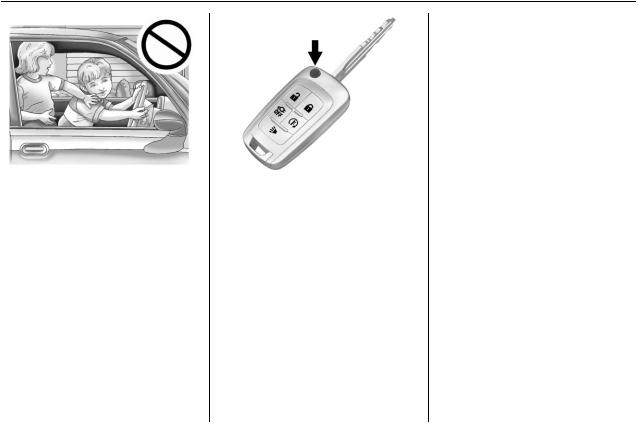
28 Keys, Doors, and Windows
The key that is part of the RKE transmitter can be used for all locks.
With DC Charging Button Shown,
Without DC Charging Similar
.Press the key release button on the RKE transmitter to extend the key.
.Press the key release button and fold the key blade to retract the key.
The key has a bar-coded key tag that the dealer or qualified locksmith can use to make new keys. Store this information in a safe place, not in the vehicle.
See your dealer if a replacement key or an additional key is needed.
If it becomes difficult to turn the key in a vehicle lock, inspect the key blade for debris. Periodically clean with a brush or pick.
If locked out of the vehicle, call the Roadside Assistance Center. See
Roadside Assistance Program
0 292. If equipped with an active OnStar subscription, an OnStar Advisor may remotely unlock the vehicle. If equipped, see OnStar Overview 0 302.
Remote Keyless Entry
(RKE) System
See Radio Frequency
Statement 0 298.
If there is a decrease in the RKE operating range:
.Check the distance. The transmitter may be too far from the vehicle.
.Check the location. Other vehicles or objects may be blocking the signal.
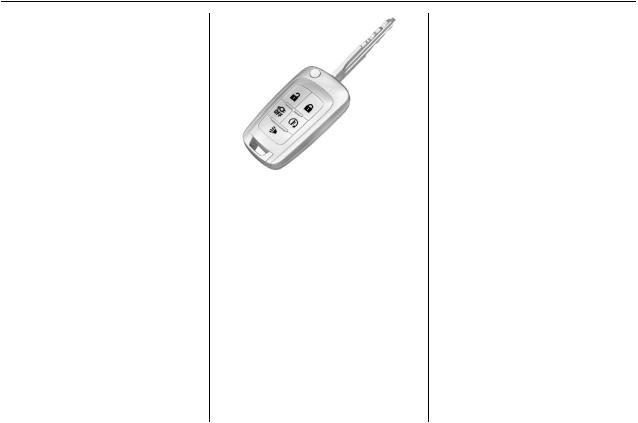
.Check the transmitter's battery. See “Battery Replacement” later in this section.
.If the transmitter is still not working correctly, see your dealer or a qualified technician for service.
Remote Keyless Entry
(RKE) System Operation
The RKE transmitter functions may work up to 60 m (195 ft) away from the vehicle.
Other conditions, such as those previously stated, can impact the performance of the transmitter.
Keys, Doors, and Windows 29
With DC Charging Button Shown, Without DC Charging Similar
K (Unlock) : Press once to unlock the driver door. Press a second time within five seconds to unlock all doors.
The hazard warning lamps will flash twice each time the button is pressed and the anti-theft alarm system will be disarmed. See
Vehicle Alarm System 0 37.
Q (Lock) : Press to lock all doors. The hazard warning lamps will flash once and the anti-theft alarm system will be armed. See Vehicle Alarm System 0 37.
If the driver door is open when Q is pressed, all doors lock and then the driver door will unlock if the Unlocked Door Anti Lock Out feature is enabled through the vehicle personalization. See “Unlocked Door Anti Lock Out” under Vehicle Personalization
0 121. This may vary based on vehicle personalization.
7 (Panic Alarm) : Press and release one time to initiate vehicle locator. The exterior lamps flash and the horn chirps three times. Press and hold for three seconds to sound the panic alarm. The horn sounds and the turn signals flash for
30 seconds. Press again or start the vehicle to cancel the panic alarm.
U (Remote Start) : Press and release Q and then immediately
press and hold U for at least four seconds to start the vehicle's
heating or air conditioning systems and rear window defogger from outside the vehicle using the RKE transmitter. See Remote Start 0 32.
